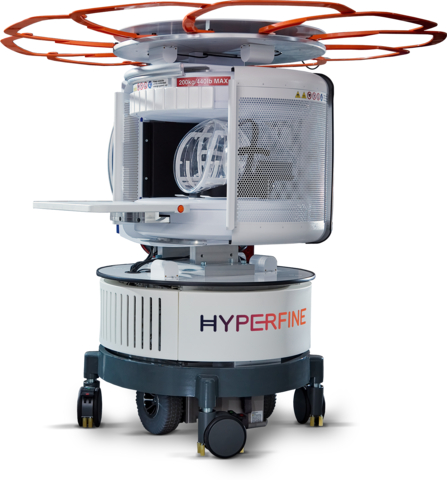Researchers to Monitor Astronaut Brain Health Using Images Acquired with the Hyperfine, Inc. Swoop® Portable MR Imaging® System

(Photo: Business Wire)
Researchers will utilize the Swoop® Portable MR Imaging® system at a SpaceX facility in
The principal investigator, Donna Roberts, MD, MS, from the Medical University of
The Swoop® system will acquire MR brain images of the four Polaris Dawn crewmembers at critical points before and after spaceflight—seven days before launch, within hours of return, and one day after return. These images will provide data to help researchers determine whether intracranial venous congestion occurs during spaceflight or during the brain’s re-adaptation to Earth.
Maria Sainz, President and CEO of Hyperfine, Inc., stated, "At Hyperfine, Inc., we are dedicated to enhancing brain health, and this research has the potential to advance neurological research. This collaboration showcases the versatility and robustness of our system and the potential of our groundbreaking technology to go into nearly any professional healthcare setting."
For more information about the Swoop® Portable MR Imaging® system, please visit hyperfine.io.
For more information about the Polaris Dawn mission, please visit polarisprogram.com.
About the Swoop® Portable MR Imaging® System
The Swoop® Portable MR Imaging® system is
About Hyperfine, Inc.
Hyperfine, Inc. (Nasdaq: HYPR) is the groundbreaking health technology company that has redefined brain imaging with the Swoop® system—the first FDA-cleared, portable, ultra-low-field, magnetic resonance brain imaging system capable of providing imaging at multiple points of care. The mission of Hyperfine, Inc. is to revolutionize patient care globally through transformational, accessible, clinically relevant diagnostic imaging. Founded by Dr. Jonathan Rothberg in a technology-based incubator called 4Catalyzer, Hyperfine, Inc. scientists, engineers, and physicists developed the Swoop® system out of a passion for redefining brain imaging methodology and how clinicians can apply accessible diagnostic imaging to patient care. For more information, visit hyperfine.io.
The Hyperfine logo, Swoop, and Portable MR Imaging are registered trademarks of Hyperfine, Inc.
Forward-Looking Statements
This press release includes “forward-looking statements” within the meaning of the “safe harbor” provisions of the Private Securities Litigation Reform Act of 1995. Actual results of Hyperfine, Inc. (the “Company”) may differ from its expectations, estimates and projections and consequently, you should not rely on these forward-looking statements as predictions of future events. Words such as “expect,” “estimate,” “project,” “budget,” “forecast,” “anticipate,” “intend,” “plan,” “may,” “will,” “could,” “should,” “believes,” “predicts,” “potential,” “continue,” and similar expressions (or the negative versions of such words or expressions) are intended to identify such forward-looking statements. These forward-looking statements include, without limitation, the Company’s goals and commercial plans, the benefits of the Company’s products and services, and the Company’s future performance and its ability to implement its strategy. These forward-looking statements involve significant risks and uncertainties that could cause the actual results to differ materially from the expected results. Most of these factors are outside of the Company’s control and are difficult to predict. Factors that may cause such differences include, but are not limited to: the success, cost and timing of the Company’s product development and commercialization activities, including the degree that the Swoop® system is accepted and used by healthcare professionals; the impact of COVID-19 on the Company’s business; the inability to maintain the listing of the Company’s Class A common stock on the Nasdaq; the Company’s inability to grow and manage growth profitably and retain its key employees; changes in applicable laws or regulations; the inability of the Company to raise financing in the future; the inability of the Company to obtain and maintain regulatory clearance or approval for its products, and any related restrictions and limitations of any cleared or approved product; the inability of the Company to identify, in-license or acquire additional technology; the inability of the Company to maintain its existing or future license, manufacturing, supply and distribution agreements and to obtain adequate supply of its products; the inability of the Company to compete with other companies currently marketing or engaged in the development of products and services that the Company is currently marketing or developing; the size and growth potential of the markets for the Company’s products and services, and its ability to serve those markets, either alone or in partnership with others; the pricing of the Company’s products and services and reimbursement for medical procedures conducted using the Company’s products and services; the Company’s estimates regarding expenses, revenue, capital requirements and needs for additional financing; the Company’s financial performance; and other risks and uncertainties indicated from time to time in Company’s filings with the Securities and Exchange Commission, including those under “Risk Factors” therein. The Company cautions readers that the foregoing list of factors is not exclusive and that readers should not place undue reliance upon any forward-looking statements, which speak only as of the date made. The Company does not undertake or accept any obligation or undertaking to release publicly any updates or revisions to any forward-looking statements to reflect any change in its expectations or any change in events, conditions or circumstances on which any such statement is based.
View source version on businesswire.com: https://www.businesswire.com/news/home/20240911316319/en/
Media
Dana Schroeder
Health+Commerce
dana@healthandcommerce.com
Investor
Marissa Bych
Gilmartin Group LLC
marissa@gilmartinir.com
Source: Hyperfine, Inc.







